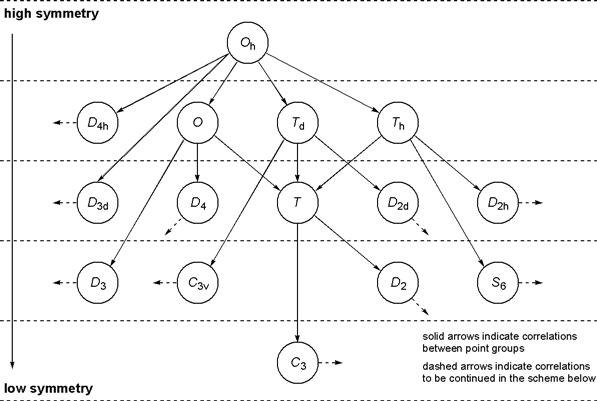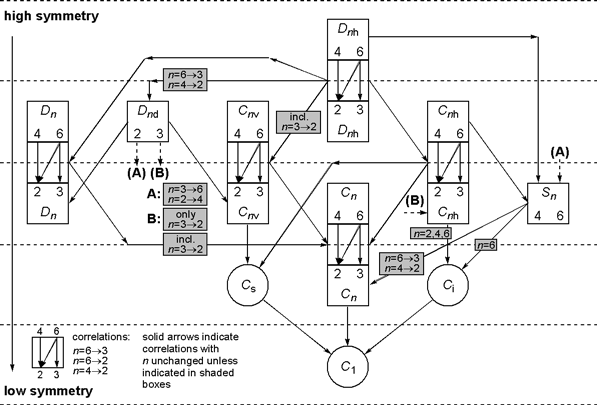| TUD Organische Chemie | Immel | Tutorials | Symmetry | Hierarchy of Point Groups | View or Print (this frame only) |
Hierarchy of Point Groups:
The question which point group (i.e. which molecular conformation or geometry) is 'more symmetrical' than another can only be answered if one point group is a sub-group of the other group. Otherwise, the decision if for example a C4 symmetrical molecule is more symmetrical than one of the C6 point group would involve purely aesthetic considerations. The table below gives a full correlation matrix between the 32 crystallographic point groups, where the initial high-symmetry groups are listed in the first column, and correlations with 'less symmetrical' groups are indicated in the corresponding row ('X' and '+'). A table of this kind gives an indication which reduction of symmetry may be expected from rotation, vibration, or substitution of a molecular geometry. For example, as indicated by dark gray shading ('X'), the Th point group is a sub-group of Oh (see first row of matrix). Light grey shadings ('+') indicate, that the correlated group is correlated to another sub-group of the initial high-symmetry group (e.g. the Th and D2h groups are both sub-groups of Oh, whereas D2h is also a sub-group of Th).
|
|
||||||||||||||||||||||||||||||||||||||||||||||||||||||||||||||||||||||||||||||||||||||||||||||||||||||||||||||||||||||||||||||||||||||||||||||||||||||||||||||||||||||||||||||||||||||||||||||||||||||||||||||||||||||||||||||||||||||||||||||||||||||||||||||||||||||||||||||||||||||||||||||||||||||||||||||||||||||||||||||||||||||||||||||||||||||||||||||||||||||||||||||||||||||||||||||||||||||||||||||||||||||||||||||||||||||||||||||||||||||||||||||||||||||||||||||||||||||||||||||||||||||||||||||||||||||||||||||||||||||||||||||||||||||||||||||||||||||||||||||||||||||||||||||||||||||||||||||||||||||||||||||||||||||||||||||||||||||||||||||||||||||||||||||||||||||||||||||||||||||||||||||||||||||||||||||||||||||||||||||||||||||||||||||||||||||||||||||||||||||||||||||||||||||||||||||||||||||||||||||||||||||||||||||||||||||||||||||||||||||||||||||||||||||||||||||||||||||||||||||||||||||||||||||||||||||||||||||||||||||||||||||||||||||||||||||||||||||||||||||||||||||||||||||||||||||||||||||||||||||
The only groups not having any correlation to Cs (= S1), Ci (= S2), or any of the Sn (S4 or S6) groups
are Cn (n ≥ 1), Dn (n ≥ 2), T, O, and I (not a crystallographic point group). Therefore, these
(and only these!) point groups must be chiral (bold face symbols in the first column, see also 'Chiral and Polar Point Groups').
|
|||||||||||||||||||||||||||||||||||||||||||||||||||||||||||||||||||||||||||||||||||||||||||||||||||||||||||||||||||||||||||||||||||||||||||||||||||||||||||||||||||||||||||||||||||||||||||||||||||||||||||||||||||||||||||||||||||||||||||||||||||||||||||||||||||||||||||||||||||||||||||||||||||||||||||||||||||||||||||||||||||||||||||||||||||||||||||||||||||||||||||||||||||||||||||||||||||||||||||||||||||||||||||||||||||||||||||||||||||||||||||||||||||||||||||||||||||||||||||||||||||||||||||||||||||||||||||||||||||||||||||||||||||||||||||||||||||||||||||||||||||||||||||||||||||||||||||||||||||||||||||||||||||||||||||||||||||||||||||||||||||||||||||||||||||||||||||||||||||||||||||||||||||||||||||||||||||||||||||||||||||||||||||||||||||||||||||||||||||||||||||||||||||||||||||||||||||||||||||||||||||||||||||||||||||||||||||||||||||||||||||||||||||||||||||||||||||||||||||||||||||||||||||||||||||||||||||||||||||||||||||||||||||||||||||||||||||||||||||||||||||||||||||||||||||||||||||||||||||||||
The following schemes provide an graphical overview on the correlations amongst the various crystallographic point groups. Point groups are arranged with decreasing symmetry, and correlations
are indicated by arrows. For the sub-groups of the high-symmetry cubic point groups the correlation is continued in the second scheme.
  |
|||||||||||||||||||||||||||||||||||||||||||||||||||||||||||||||||||||||||||||||||||||||||||||||||||||||||||||||||||||||||||||||||||||||||||||||||||||||||||||||||||||||||||||||||||||||||||||||||||||||||||||||||||||||||||||||||||||||||||||||||||||||||||||||||||||||||||||||||||||||||||||||||||||||||||||||||||||||||||||||||||||||||||||||||||||||||||||||||||||||||||||||||||||||||||||||||||||||||||||||||||||||||||||||||||||||||||||||||||||||||||||||||||||||||||||||||||||||||||||||||||||||||||||||||||||||||||||||||||||||||||||||||||||||||||||||||||||||||||||||||||||||||||||||||||||||||||||||||||||||||||||||||||||||||||||||||||||||||||||||||||||||||||||||||||||||||||||||||||||||||||||||||||||||||||||||||||||||||||||||||||||||||||||||||||||||||||||||||||||||||||||||||||||||||||||||||||||||||||||||||||||||||||||||||||||||||||||||||||||||||||||||||||||||||||||||||||||||||||||||||||||||||||||||||||||||||||||||||||||||||||||||||||||||||||||||||||||||||||||||||||||||||||||||||||||||||||||||||||||||